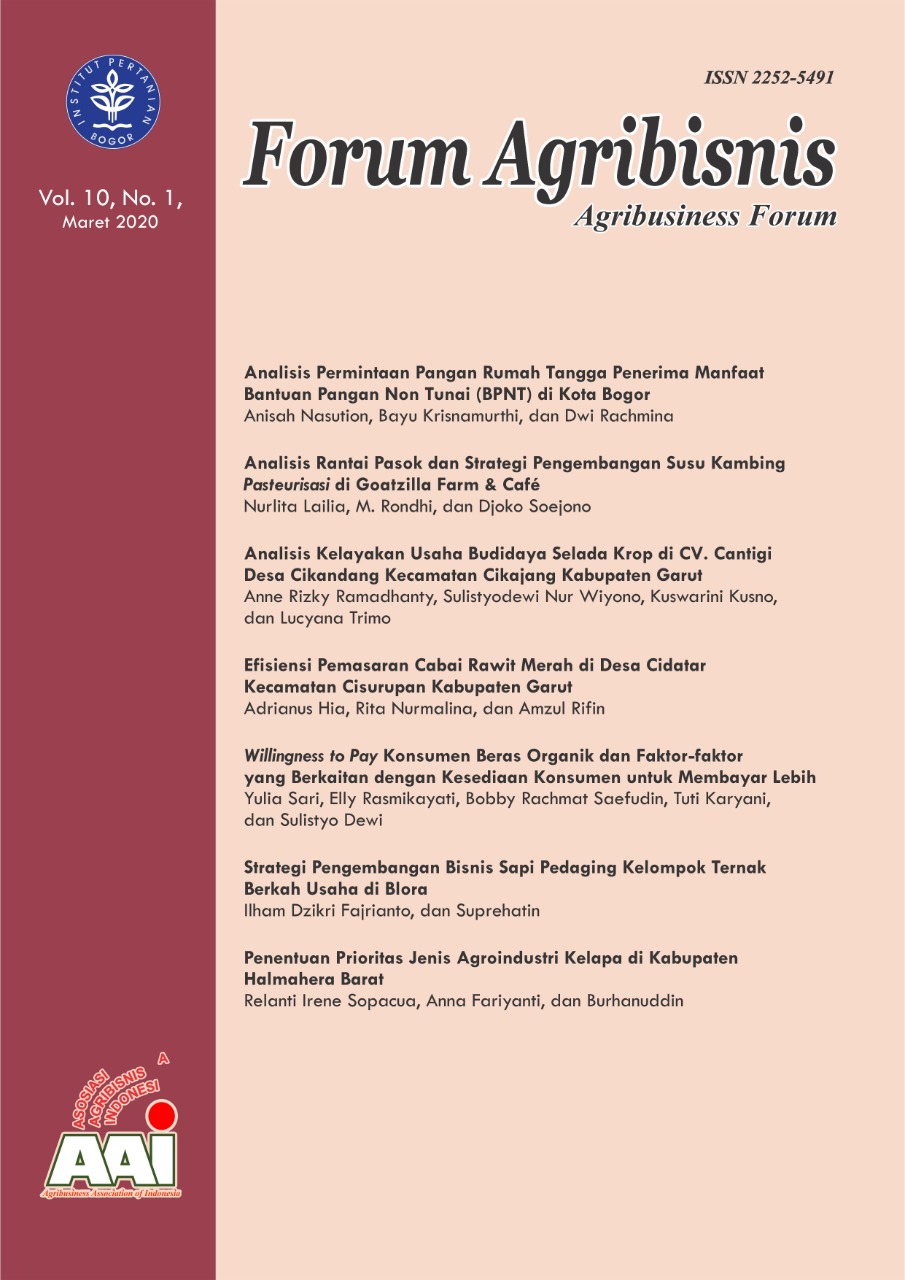Penentuan Prioritas Jenis Agroindustri Kelapa di Kabupaten Halmahera Barat
Main Article Content
Abstract
The main source of farmer households in West Halmahera is coconut plantations. Coconut fruit is produced, some are sold in the form of whole fruit, some are processed into copra. For this agro-industry development effort to work effectively, it is necessary to determine the type of coconut agroindustry that will be developed by considering the factors that increase, the efforts of the businesses involved and the objectives of each of the agro-industries. The purpose of this study was to determine the priorities of coconut agro-industry that had to be developed in West Halmahera Region. The data were analyzed using the Process Hierarchy Analysis (AHP) approach and internal-external factor. The results showed that the virgin coconut oil (VCO) agro-industry had the highest priority in the development of coconut agro-industry in West Halmahera. By the development of this agro-industry, business actors will gain added value, affect the increase in income, and will open new jobs in the rural area. The important factors that have influenced the development of agro-industry were human resources (HR) and asset. Furthermore, each actor involved has a firm role and linkage to each of the determinants of agro-industry business development. Farmers have the main role (37%) on the availability of raw materials, farmer groups have strong correlation (42%) to human resources, the government plays an important role (42%) in infrastructure development, and academics have an enormous contribution (34%) in providing technology for the development of agro-industry. Overall, the most important actors in the development of coconut agro-industry in West Halmahera are farmer groups. The Strategy applied to agro-industry virgin coconut oil (VCO) at West Halmahera Region is intensive: market penetration, market development and product development.
Downloads
Article Details

This work is licensed under a Creative Commons Attribution-ShareAlike 4.0 International License.
The author submitting the manuscript must understand and agree that the copyright of the article manuscript must be submitted/transferred to the Journal Forum Agribisnis. This work is licensed under the Creative Commons Attribution-ShareAlike 4.0 (CC BY-SA) International License in which the Author and Reader can copy and redistribute the material in any media or format, and remix, modify and build material for any purpose, but they must provide appropriate credit (citing articles or content), provide a link to the license, and indicate whether there is a change. If you mix, change, or create material, you must distribute your contribution under the same license as the original.
References
Budianto JD. Allolerung. 2003. Kelembagaan perkelapaan. Prosiding Konferensi Nasional Kelapa V. Tembilahan, 22-24 Oktober 2002. Pusat Penelitian dan Pengembangan Perkebunan, Bogor (ID).
Budiarto. 2010. Pembangunan ekonomi perdesaan melalui agroindustri: Penentuan prioritas pengembangan jenis agroindustri kelapa di Kabupaten Kulonprogo. J. SEPA 7 (1): 6-14.
David FR. 2012. Strategic management: a competitive advantage approach, concepts and cases (14th Edition). New Jersey: Prentice Hall.
Evalia NA. 2015. Strategi pengembangan agroindustri gula semut aren. J. Manajemen & Agribisnis. 12(1):57-67.
Fadhil R, Maarif MS, Bantacut T, Hermawan A.2017.Model strategi pengembangan sumber daya manusia agroindustri kopi gayo dalam menghadapi masyarakat ekonomi ASEAN.J. Manajemen Teknologi 16 (2): 141-156.
Henderson BB, Henry L, MacAulay G. 2006. Investment and change in the coconut industry of North Sulawesi: an equilibrium displacement analysis. Australian agricultural and resource economics society. 50th annual conference;8-10 February 2006; Sydney, NSW (AUS).
Jakfar AA. 2014. Mendorong daya saing industri di Madura melalui pendekatan klaster industri. J.Agrointek. 8(2):75-84.
Krishnakumar V, Kalavathi S, Thomas RJ, Thomas GV. 2013. Diversification of coconut based farming system through community based organizations for income generation and sustaining productivity. J. Plantation Crops. 41(3): 271-276.
Kuncoro M. 2012. Ekonomika Pembangunan. Jakarta: Penerbit Erlangga.
Lay A, Pasang PM. 2012. Strategi dan Implementasi Pengembangan produk kelapa masa depan. J. Perspektif. 11 (1): 01-22.
Manikantan MR, Ambrose RPK, Alavi S. 2015. Flow-specifc physical properties of coconut flours.J. International Agrophysics. 29:1-7. doi: 10.1515/intag-2015-000.
Mannekote JK, Kailas SV. 2013. Value added products from Coconut oil. J. Indian Coconut [Internet]. [diunduh: 20 Agustus 2018]. Tersedia pada:https://www.researchgate.net/profile/Jagadeesh_Kumar_Mannekote/publication/237803592_Value_added_products_from_Coconut_oil/links/0c96051bbf3e37fea1000000/Value-added-products-from-Coconutoil.pdf?origin=publication_detail.
Marimin, Maghfiroh. 2010. Aplikasi tekhnik pengambilan keputusan dalam manajemen rantai pasok. IPB Press. Bogor (ID).
Moran, Brightman. 2000. Leading organizational change. J. Workplace learning: Employee counselling today. 12 (2): 66-74.
Muyengi ZE, Msuya E, Lazaro E. 2015. Assessment of factors affecting coconut production in Tanzania.J. Agricultural Economics and Development. 4(6): 083-094.
Pathiraja PMEK, Griffith GR, Farquharson RJ, Faggian R. 2015. The Sri Lanka coconut industry: current status and future prospects in a changing climate. Australasian agribusiness perspectives.
Saaty TL. 1990. How to make a decision: The analytic hierarchy process. J. European of Operation Research. 48:9-26.
Suharto JC. 2018. Potentials for increasing farmers' income and enhancing competitiveness of the coconut industry through alternative uses [Internet]. [diunduh: 18 Agustus 2018]. Tersedia pada: https://www.bioversityinternational.org/fileadmin/bioversity/publications/Web_version/198/ch03.html.
Ulrich KT, Eppinger SD. 2001. Perancangan dan pengembangan produk. Salemba Teknika, Jakarta (ID).
Yeap SW, Beh BK, Ali NM, Yusof HM, Ho WY, Koh SP, Altheen. 2014. Antistrees and antioxidant effects of virgin coconut oil in vivo [Internet]. [diunduh 8 Agustus 2018]. Tersedia pada: https://doi.org/10.3892/etm.214

